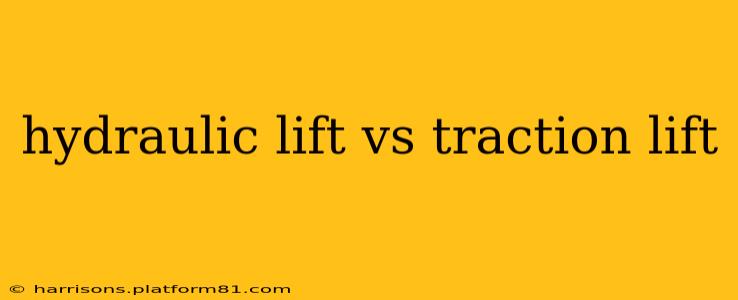Hydraulic Lift vs. Traction Lift: A Comprehensive Comparison
Choosing the right elevator system for a building is a crucial decision, impacting safety, efficiency, and long-term costs. Two primary types dominate the market: hydraulic lifts and traction lifts. Understanding their differences is key to making an informed choice. This comparison delves into the key distinctions between hydraulic and traction elevators, helping you determine which best suits your needs.
What is a Hydraulic Lift?
Hydraulic lifts, also known as hydraulic elevators, use a piston or ram powered by hydraulic fluid to raise and lower the elevator car. The piston is located in a pit beneath the elevator shaft, and the fluid is pressurized to lift the car. This system is particularly well-suited for low-rise buildings (typically up to six stories).
What is a Traction Lift?
Traction lifts, conversely, employ a system of cables, counterweights, and a motor to move the elevator car. The motor drives a sheave (pulley) that rotates, winding and unwinding the cables to raise and lower the car. This system is more common in high-rise buildings due to its efficiency in traversing greater heights.
What are the key differences between hydraulic and traction lifts?
This is a common question, and understanding the core differences is paramount. Let's break it down:
1. Speed and Efficiency:
- Hydraulic Lifts: Generally slower than traction lifts, especially over multiple floors. The speed is limited by the hydraulic pump's capacity and the piston's stroke. Energy efficiency can be lower compared to traction lifts, particularly in taller buildings.
- Traction Lifts: Can achieve significantly higher speeds, making them ideal for high-rise buildings and situations demanding faster transport. They are generally more energy-efficient, especially in taller buildings, as they utilize counterweights to offset the car's weight.
2. Installation and Maintenance:
- Hydraulic Lifts: Require a deep pit beneath the elevator shaft to house the hydraulic piston and reservoir. This can increase installation costs and complexity, especially in buildings with limited underground space. Maintenance may involve more frequent oil changes and potential leaks.
- Traction Lifts: Typically require a smaller pit and machine room, simplifying installation and potentially reducing costs. While maintenance is necessary, it often involves less frequent and less complex procedures compared to hydraulic systems.
3. Environmental Impact:
- Hydraulic Lifts: Employ hydraulic fluid, which can pose environmental concerns if leaks occur. The energy consumption can be higher, especially in taller buildings, leading to a larger carbon footprint.
- Traction Lifts: Generally considered more environmentally friendly due to lower energy consumption and the absence of hydraulic fluid. Modern traction lifts often incorporate energy-saving technologies, further reducing their environmental impact.
4. Cost:
- Hydraulic Lifts: Installation costs can be lower for low-rise buildings due to simpler construction. However, ongoing maintenance costs may be higher over time due to potential leaks and fluid replacement.
- Traction Lifts: Initial installation may be more expensive, especially for high-rise applications. However, long-term operating and maintenance costs tend to be lower due to increased efficiency and less frequent maintenance.
Which type of lift is right for me?
The best choice depends entirely on your specific needs and building characteristics:
- Low-rise buildings (typically up to six stories): Hydraulic lifts are often a cost-effective option.
- High-rise buildings (seven stories and above): Traction lifts are almost always the preferred choice due to their speed, efficiency, and capacity.
- Buildings with limited underground space: Traction lifts might be the more practical option, requiring a smaller pit.
- Buildings with environmental concerns: Traction lifts generally have a lower environmental impact.
Ultimately, consulting with an elevator specialist is crucial for making the best decision. They can assess your specific needs, evaluate your building's characteristics, and recommend the optimal lift system based on factors like building height, passenger traffic, budget, and environmental considerations. This ensures you select the most appropriate and efficient solution for your project.
